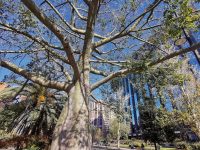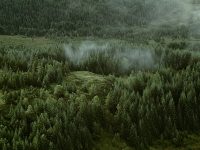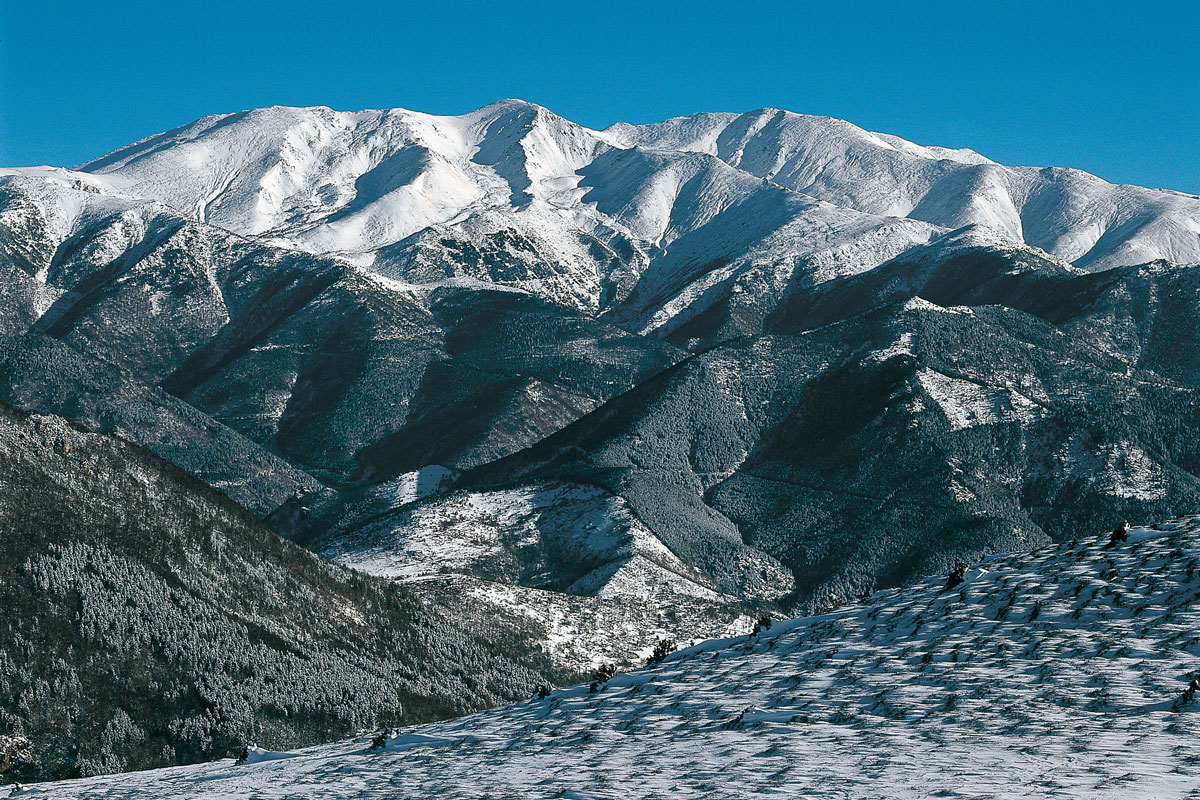
Many scientists tend to think a landscape is, simply, «that which surrounds us». Historically, this concept was never an exact synonym of the idea of territory, rather, it was born at the hands of certain painters and writers in the 16th century to refer to a piece of land of artistic value. Was there anyone else, prior to these painters and writers, who had a feeling for landscapes? In fact, this is currently one of the great debates in the area of Humanities.

We differentiate figure and background. If we can observe the landscape is because of the simplification process our mind carries out. / Source E. Rubin, 1921. Visuell wahrgenommene figuren. Studien in psychologischer analyse. Doctoral thesis. Gyldendalske boghandel. Copenhaguen.
Territory, land and environment are concepts we use for the representation of the world, but are not quite the same as «landscape». Landscape is a special kind of view of a land. In order to get to this concept, the world as it is must be processed in two different ways. First, transforming it in a mental picture of the world; and then, valuing it, feeling it and judging it from an aesthetic point of view. Landscape is like a butterfly —in order to exist it must undergo a double mutation. First, it must be born as a caterpillar or particular phenomenon —a particular view, a particular outlook, a particular land— secondly, it must turn into a butterfly or aesthetic idea. This can be a daily, beautiful and rich in colours butterfly— Fairview, Springfield— or nocturnal, ugly and even horrific —Arizona. In any case it will always be judged from an aesthetic point of view. Only research that takes into account that landscape is like a butterfly and considers this double mutation can give an accurate account of its nature.
From «the world as it is» to the concept of land
«Landscape is a portion of land that has a sense of unity and independence because there is an individual paying attention to it»
Landscape is, first of all, land. I mean, a representation of part of the world. Landscape is a portion of land that has a sense of unity and independence because there is an individual paying attention to it. In spite of its simplicity, we must talk of process and genesis at this point. What is more, admiration of the landscape is probably the most obvious and basic scenario in which our minds process data received through our senses.
The lack of a well defined term makes us mistake landscape with spatial continuum. And, because its constituents are varied —from trees and weed, to buildings and motorways— it is sometimes considered as something disconnected and chaotic. However, in spite of these problems, we seem to clearly perceive a landscape. How can this be possible? Why do we see landscapes? This is possible due to mind processing —filtration. Regarding the landscape, this filtration is reduced to demarcation and unification.
Georg Simmel was one of the first to attempt a definition of landscape in the early 20th century. In an article entitled «The Philosophy of Landscape» Simmel tries to find its origins: «demarcation is absolutely essential for landscape, since it is framed within a visual horizon, whether it is a momentary frame or a long-lasting one». Indeed, landscape is a «piece» of nature that insists on breaking away from the whole. If it is possible for the human mind, as Simmel suggests, to conceive the breaking of nature it is because of humans’ own subjectivity.
But the perception of the landscape is not only explained with the concepts of partiality and demarcation. Demarcation of a space implies an essential unity of the whole. However, this unity would be more efficient if, once our landscape is demarcated, we valued the elements that make up this landscape. Contemplating the landscape cannot be put on a level with discerning the elements in it.
Recently, a French philologist specialised in landscape, Michel Collot, reduced to three the mental processes used in the origins of the concept. Based on perception psychology and the Gestalt laws, Collot concluded that these three were: a tendency to selection, a tendency to relate things and a tendency to foresee the unseen based on our previous knowledge. Our tendency to select avoids the saturation of our minds. We simplify what we see and do not watch carefully at every single element that makes up the landscape, we see it as a whole. Simplification has a lot to do with the second tendency as well. We make groups with the elements we see according to their size, colour, nearness… and facilitate la vision d’ensamble or overall view. Finally, the third process enables the observer to complete the uncompleted, and takes into account both what is visible at the moment and what is invisible.
From land to landscape
To determine the perceptive origins of the landscape is not enough to define the concept. The perception of landscape is similar to the perception of land but they have been two different concepts for centuries. Why is it so? Because landscape is something more than land. Landscape is a land seen from an artistic or aesthetic point of view.
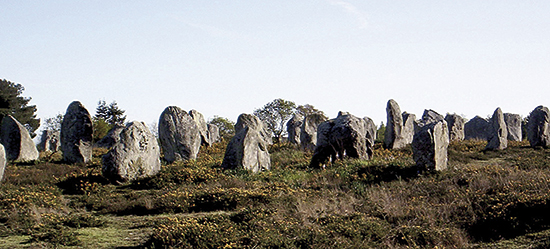
It is possible that the idea of landscape was there long before the word landscape appeared, when humans used stones for the demarcation of territory, thus establishing an emotional link with them. This picture belongs to a megalithic site found in Brittany.
If we are so sure of the aesthetic content of the word is because of its etymological origins. The term began to be used by the 17th century in English within the context of artistic painting. The word land already existed and they felt they needed a new word to denote landscape— those parts of land that were worthy of the artist’s attention. Landscape was a piece of land that was unified by a person’s particular perception that valued it for itself from an aesthetic point of view.
«The most common position among researches is to link the origins of the concept to art»
But we still need to know when that aesthetic view of the land that turned it from land to landscape arose. There are three main positions regarding the subject. The first one insists on the importance of the appearance on the scene of a particular word charged with aesthetic connotations in order to be able to speak of the origins of the concept. Secondly, there is another position, held by most culture and art historians, which prefers to magnify the worth of the development of some artistic practices to talk about the birth of landscape. Finally, there is a third position that holds that it is not necessary for a word or an artistic movement to exist in order to talk about a landscape attitude, which can be also perceived in the figure of the traveller or the stroller.
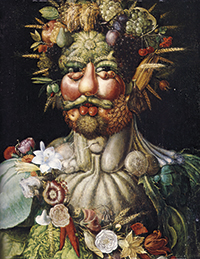
To perceive the whole does not mean perceiving its parts, since every landscape entails a visual unity. This work by Arcimboldo represents a human face made up of fruits and flowers. Isolated they are merely fruits and flowers, but put together they make the portrait of Rudolf II, Holy Roman Emperor. Vertumnus, 1590-1591. Oil on wood, 56 x 68 cm. / Source: Skokloster slott
Maybe the primitive experience of landscape existed long before the word or landscape painting appeared. Anyone staring in awe at a nice view would be glad to defend this hypothesis. It is usual to turn to Petrarch’s experience at Mont Ventoux in order to talk about this idea, since we know that in Petrarch’s time neither the word nor the painting existed. Were there others before Petrarch capable of feeling the beauty of the territory even if they lacked a term for it? Answers to this question are many and controversial. Some, like Venturi Ferriolo, Milani or Baridon turn to antiquity to talk about this kind of experience. They base their ideas on gardening and literature. In any case, as Careri points out, would it not be appropriate to consider its existence even before that, in prehistory, when travellers and nomads used to demarcate some territories with stones and landmarks, thus establishing an emotional link with them?
The most common position among researches is to link its birth to art. Some authors insist on the fact that in other cultures, particularly in China, landscape painting started long before it did en Europe. But most researchers prefer to defend that, at least in Europe, it appeared during the Renaissance. Dürer’s art or Leonardo’s can be set in the middle of this change of mentality. The development of Humanism and the study of nature meant a greater confidence in our senses and an honest interest for the creature around us. Thus, the origin of the concept is linked to new ideas shared first by some pioneers and later on by the cultured classes in Italy, France, the Netherlands or Germany. This position is held by Roger, Cauquelin, Maderuelo and many others.
«Our tendency to select avoids the saturation of our minds»
Finally, other researchers claim that we can only be sure of the appearance of the concept of landscape on the scene when the word appears. Is it completely necessary for a word to exist to talk about the existence of the concept? Of course, there is nothing more effective than the analysis of the appearance of new words in the historical analysis of the evolution of mentality in a society. Benjamin L. Whorf holds that nothing indicates more clearly the cultural differences between societies than their vocabulary. There are communities in Africa that only count from one to five. The Inuits have more than ten words that refer to different kinds of snow, whose differences are unnoticeable for us. Does that mean that those who do not have the word or words to refer to landscape are not capable of appreciating it in the same way? That is the position held by the geographer Augustin Berque, who has tried to demonstrate in his study that we can only talk of «landscape societies» if they have a word for it.
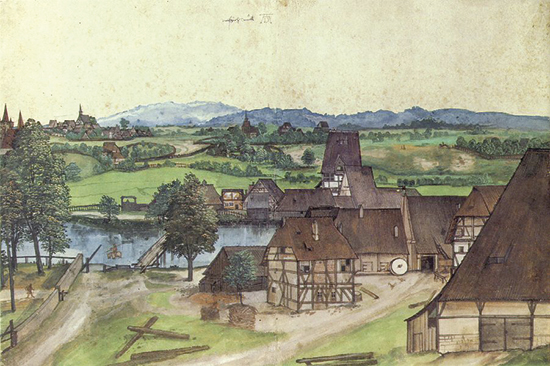
Albrecht Dürer. The Wire-drawing Mill, 1489. Water colours, 42,6 x 28,6 cm. From the Middle Ages onwards, landscape becomes something worthy of being painted by itself, for its aesthetic value. «The word landscape did not appear as a synonym for territory, land or environment, but as an aesthetic term» / Source: Staatliche Museen zu Berlín – Preußischer Kulturbesitz
It is unquestionable that the appearance of the term «landscape» is crucial for the origins of the idea. Be it as it may, if someone thought it was necessary to make this word up is because there was some kind of experience worthy of a new word. In short, the origins of the concept are reduced to three phases —a perceptive one, an affective one and, finally, a conceptual one.
Bibliography
Baridom, M., 2007. Naissance et renaissance du paysage. Actes Sud. Arles.
Berque, A., 1995. Les Raisons du paysage. De la Chine antique aux environnements de synthèse. Hazan. París.
Burckhardt, J., 1941. «El descubrimiento de la belleza en el paisaje». La cultura del renacimiento en Italia. Escelicer. Madrid.
Careri, F., 2002. Walkscapes. El andar como práctica estética. Gustavo Gili. Barcelona.
Cauquelin, A., 1989. L'invention du paysage. Librairie Plon. París.
Collot, M., 1995: «Point de vue sur la perception des paysages». In Roger, A., 1995. La Théorie du Paysage en France (1974-1994). Champ Vallon. Seyssel.
Escande, Y., 2005. Montagnes et eaux. La culture du shanshui. Hermann. París.
López Silvestre, F., 2006. «A xénese da paisaxe». A paisaxe contemporánea. Consello da Cultura Galega. Santiago de Compostela.
Maderuelo, J., 2005. El Paisaje. Génesis de un concepto. Abada. Madrid.
Milani, R., 2008. El arte del paisaje. Biblioteca Nueva. Madrid.
Roger, A., 2007. Breve tratado del paisaje. Biblioteca Nueva. Madrid.
Simmel, G., 1986. «Filosofía del Paisaje». El Individuo y la Libertad. Península. Barcelona.
Venturi Ferriolo, M., 2002. Etiche del paesaggio. Il progetto del mondo umano. Editori riuniti. Roma.
Whorf, B. L., 1971. Lenguaje, pensamiento y realidad. Ed. Barral. Barcelona.


